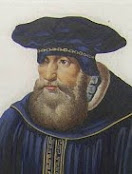NEW - Nicola Abbagnano - philosopher
Thinker who championed ‘positive existentialism’
The philosopher Nicola Abbagnano, best known for his advancement of what he defined as positive existentialism, was born on July 15, 1901 in Salerno in Campania. Abbagnano, who spent much of his adult life in Turin, Milan and the Ligurian resort town of Santa Margherita Ligure, developed a philosophy that emphasised human possibility and freedom, rejecting more traditional existentialist discussions that focussed on how the struggle to create purpose in an inherently meaningless world can engender feelings of anguish and despair. Many years on from his death in 1990, Abbagnano’s legacy of intellectual optimism continues to inspire philosophers who seek a balanced, pragmatic approach to existential questions, while his emphasis on ethical responsibility resonates in contemporary debates on human behaviour. Read more…
_____________________________________
Guido Crepax - cartoonist
Erotic character Valentina captured spirit of 1960s Italy
The cartoonist Guido Crepax, whose character Valentina became a heroine of the 1960s generation in Italy and beyond, was born on July 15, 1933 in Milan. Valentina first appeared in May 1965 as a secondary character in another cartoon, the photographer girlfriend of an art critic and amateur sleuth. But the sinuous, sensual female depicted by Crepax, her hair cut in a glossy bob, soon acquired fans both male and female. In an era when Italian society was beginning to experience a sense of sexual liberation for the first time, Valentina’s eroticism naturally attracted a legion of male fans. But her assertive individuality struck a chord with many modern Italian women, too, even if her readiness to shed her clothes caused outrage among others. Soon, Valentina left behind her fictional boyfriend and starred in a series of her own adventures. Read more…
_______________________________________
Frances Xavier Cabrini – the first American saint
Missionary who was directed to the US by the Pope
Saint Frances Xavier Cabrini, who founded a religious institute to provide support for impoverished Italian immigrants in the United States, was born on July 15, 1850 in Sant’Angelo Lodigiano, in Lombardy. Frances did such good in her life she became the first naturalised citizen of the United States to be canonised in 1946. She had been born into a family of cherry tree farmers, the youngest of 13 children. She was two months premature and remained in delicate health all her life. After her parents died she applied for admission to the Daughters of the Sacred Heart but was told she was too frail for the life. She became the headmistress of an orphanage in Codogno, about 30km (19 miles) from her hometown, where she drew in other women to live a religious life with her. She took religious vows in 1877. Read more…
Pietro Ruggeri da Stabello – poet
Talented writer kept record of 1848 rebellions and produced verses in local dialect
Prolific writer Pietro Ruggeri da Stabello, who became famous after his death for the poetry he had written in his local dialect, was born on this day in 1797 in a hamlet near Zogno in Lombardy, a short distance from the city of Bergamo. Ruggeri da Stabello wrote a valuable account of events that occurred in the north of Italy during revolts against the Austrian occupying army, which were later collected in a volume entitled Bergamo Revolution of the Year 1848. He was the second son of a Bergamo couple, Santo Ruggeri, and Diana Stella Ceribelli, who had moved to the Brembana valley to escape the riots that followed the fall of the Republic of Venice in 1797. When Pietro Ruggeri became an adult, he added the words da Stabello to his name, to honour the small village where he had grown up, which is less than one kilometre from the municipality of Zogno in Val Brembana. Read more…
______________________________________
Fire damages St Paul Outside-the-Walls
Beautiful Basilica was faithfully rebuilt and restored
A blaze nearly destroyed the ancient Papal Basilica of Saint Paul Outside-the-Walls (Basilica Papale San Paolo Fuori Le Mura) in Rome on July 15, 1823. A workman repairing the lead in the church roof accidentally started a fire that burnt down the Basilica, which dated back to the third century and was unique in Rome, having retained its primitive style. St Paul Outside-the-Walls is one of four major Papal Basilicas in Rome, along with St John in the Lateran (San Giovanni in Laterano), St Peter’s (San Pietro in Vaticano) and St Mary Major (Santa Maria Maggiore). After the fire, Pope Leo XII appealed for donations to help rebuild the church in exactly the same style. The Basilica was reopened in 1840 and reconsecrated in 1855 in the presence of Pope Pius IX. The redecoration was helped by contributions from all over the world. Read more…
_____________________________________
Book of the Day: The Cambridge Companion to Existentialism, edited by Steven Crowell
Existentialism exerts a continuing fascination on students of philosophy and general readers. As a philosophical phenomenon, though, it is often poorly understood, as a form of radical subjectivism that turns its back on reason and argumentation and possesses all the liabilities of philosophical idealism but without any idealistic conceptual clarity. The Cambridge Companion to Existentialism is a volume of original essays, the first to be devoted exclusively to existentialism in over 40 years. A team of distinguished commentators discuss the ideas of Kierkegaard, Nietzsche, Heidegger, Sartre, Merleau-Ponty and Beauvoir and show how their focus on existence provides a perspective on contemporary issues in moral psychology and philosophy of mind, language and history.Steven Crowell is Joseph and Joanna Nazro Mullen Professor of Philosophy and Chair of the Philosophy Department at Rice University in Houston, Texas. He is the author of Husserl, Heidegger, and the Space of Meaning (2001) and the editor of The Prism of the Self: Philosophical Essays in Honor of Maurice Natanson (1995).
%20(1).png)



.jpg)
.jpg)

.jpg)



.jpg)





.jpg)




